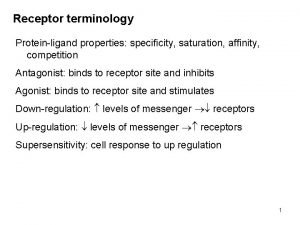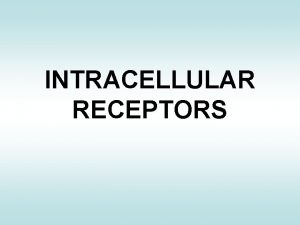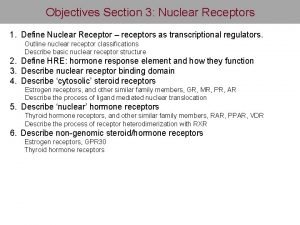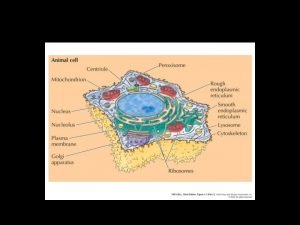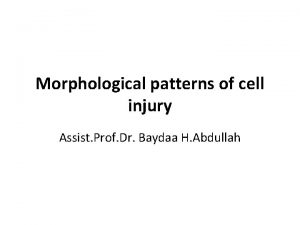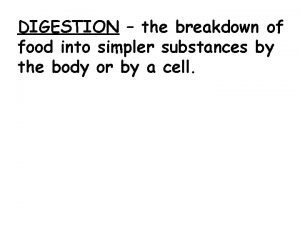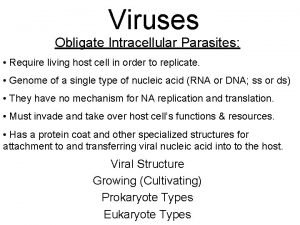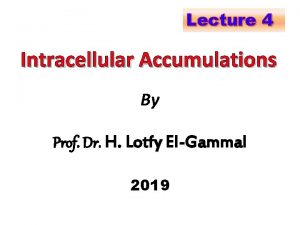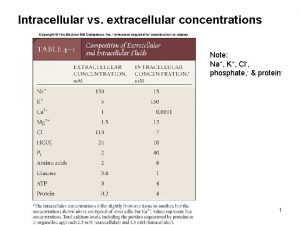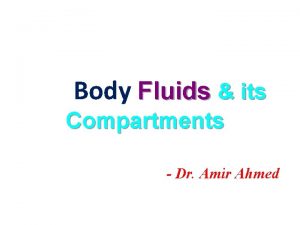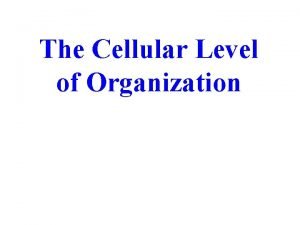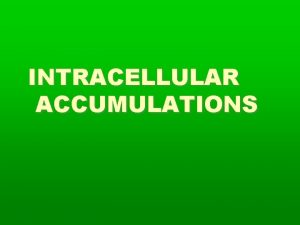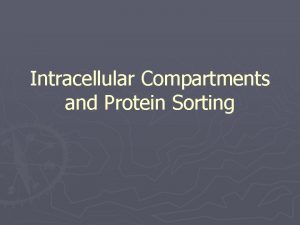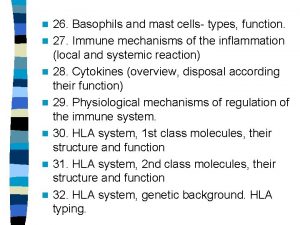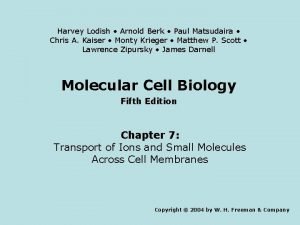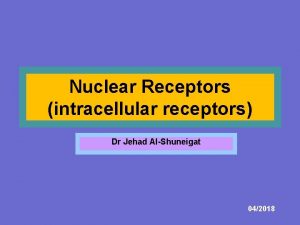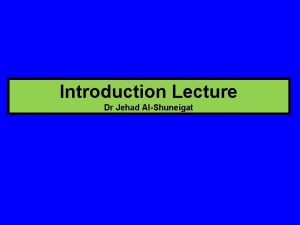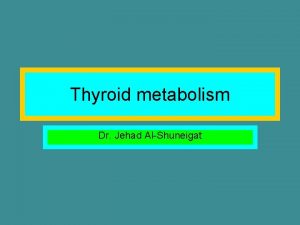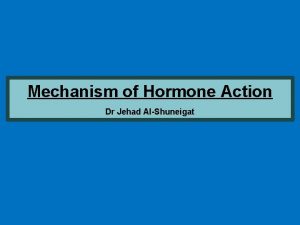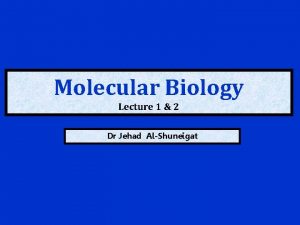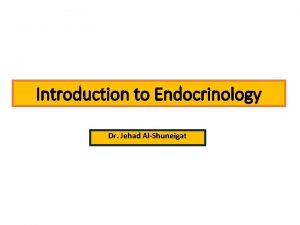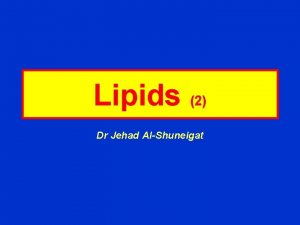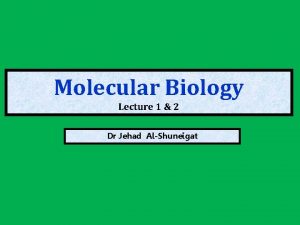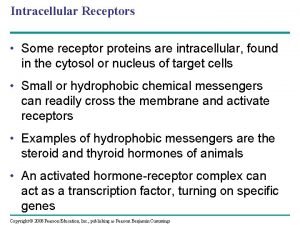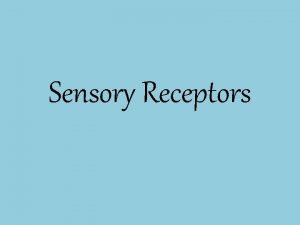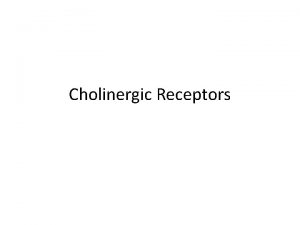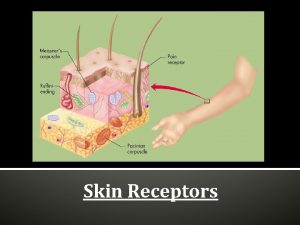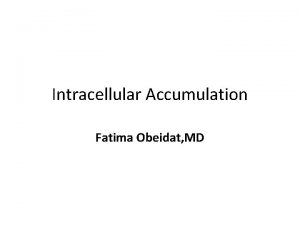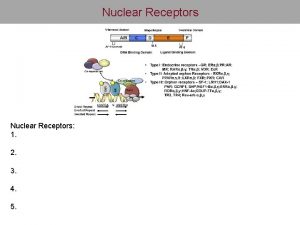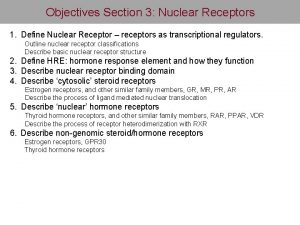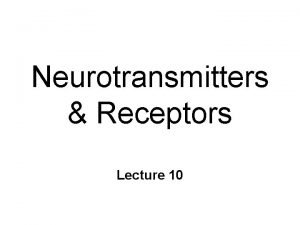Nuclear Receptors intracellular receptors Dr Jehad AlShuneigat The





















- Slides: 21

Nuclear Receptors (intracellular receptors) Dr Jehad Al-Shuneigat

The mechanism of steroid hormone action. Steroid hormones are lipid-soluble and thus readily diffuse through the plasma membrane of cells. They bind to receptor proteins in either the cytoplasm or nucleus (not shown). If the steroid binds to a receptor in the cytoplasm, the hormone-receptor complex moves into the nucleus. The hormone-receptor complex then binds to specific regions of the DNA, stimulating the production of messenger RNA (m. RNA). ﺃﻠﻨﻮﺕ

• The nuclear receptor superfamily include nuclear hormone receptors (NHRs) if we know the hormone that bind receptor and orphan nuclear receptors we don’t know wich hormone bind to the receptor and activate it. • NHRs are receptors for which hormonal ligands have been identified, whereas orphan receptors are so named because their ligands or stimulaters are unknown • Nuclear receptors are ligand-dependent transcription factors that have important roles including cell proliferation, differentiation and cellular homeostasis. • The primary function of nuclear receptors is to mediate transcriptional responses to hormones through the recruitment of a range of positive and negative regulatory proteins, referred to as co-activators or co-repressors. The recruitment of coactivator complexes is a crucial step in ligand-induced transcription, whereas the recruitment of co-repressor complexes mediates active repression of unliganded nuclear receptors.

• Often the hormones together with nuclear receptors function as inducers or repressors of gene expression. • In the case of the cytosolic receptors, the hormone binding induces translocation into the nucleus where the hormone-receptor complex binds a DNA element and alters the transcription of the target gene. • Transcription factor, defined as any regulatory protein that directly influences gene transcription. • Glucocorticoid receptor and aldosterone receptor reside in the cytoplasm whereas the rest are located within the nucleus presumably in association with chromatin.

• Nuclear Receptors groups • Based on the receptor activation mechanism the nuclear receptors can be divided into two basic groups: 1 - Nuclear hormone receptors localized in the cytoplasm including glucocorticoid receptor and aldosterone receptor. • The steroid hormone receptor receives the hormonal signal in the cytosol, becomes activated by hormone binding, at which point it enters the nucleus to regulate the transcription initiation of cognate genes. 2 - Nuclear hormone receptors localized in the nucleus which include retinoic acid, the thyroid hormone (TR) and Vit. D 3.

• General structure of nuclear receptor • A typical nuclear receptor consists of: 1 - The A/B region (N-terminal region). This region is the most variable both in size and sequence and in many cases contains a ligand-independent transcription activation functions 1 (TAF-1) domain. • The A/B domain shows promoter and cell-specific activity and is the target for phosphorylation mediated by different signaling pathways, and this modification can significantly affect transcriptional activity. • Phosphorylation may increase or decrease transcription.


Structure of nucleus receptor ﺍﻟﻨﻮﺕ N terminal Tow region but merged with each other Region 2 zink region

The green color is AB region

2 - Region C or DNA binding domain (DBD): functions 1 - mediate specific recognition of the hormone response elements (HRE) by two zinc fingers besides stabilizing binding to these DNA sequence 2 - dimerization of the receptor on the HRE. • The two zinc fingers are 2 polypeptide loops each is 10 -20 amino acids long. • The zinc is bound at four positions with either four cysteine, or two cysteine and two histidine. • The Zn-motifs serve to position a recognition helix in the major groove of the DNA. • Once activated the receptors dimerize and bind with 4 zinc fingers to a short region of DNA (HRE). Each zinc finger recognize a specific sequence of about 6 nucleotides pairs in the HRE. 3 - The DNA binding domain also contain the "nuclear localization signal domain" directing the hormone/receptor complex to the HRE acceptor is accomplished by which are few amino acids.

The finger it slef is formed by 10 – 20 A. A

• Structure of receptor (dimer) binding to DNA

3 - Linker region D, serves as a hinge between the DBD and the LBD, allowing rotation of the DBD. It might allow the DBDs and LBDs to adopt several different conformations without creating steric hindrance problems. 4 - E region contains the ligand (hormone) binding domain (LBD) where the shape of the ligand-binding pocket (hydrophobic nature) matches that of the ligand (also hydrophobic). • Functions: a- binding site for the hormone, b- interaction with heat-shock proteins, c- mediate dimerization of the receptors d- transactivation and transrepression through binding of coactivators and corepressors. e- The LBDs contain the TAF-2 motif responsible for ligand-dependent transcriptional activation. • The function both TAF 1 and TAF 2 is to activate transcription. 5 - F region: its function is not clear but it thought to play a role in coactivator recruitment to the E domain.

• Hormone Response Elements (HRE) • HRE is a specific region in DNA where the DBD of the hormone recognize and binds to. • Nuclear receptors regulate transcription by binding to specific HREs. • These elements are often located close to the core promoter, in some cases they are present in enhancer regions. • The analysis of a large number of HREs revealed that a sequence of 6 bp constitutes the core recognition motif. • The consensus motifs that has been identified for steroids receptors: AGAACA.

• Homo and hetero-dimerization ﺍﻟﻨﻮﺕ • Receptors can bind as monomers, homodimers, and heterodimers to different HRE. • In dimerizations two hormone receptor monomers bind cooperatively to their response elements, and dimerization interfaces have been identified both in the ligand binding domain (LBD) and in the DNA binding domain (DBD). • The retinoid X receptor (RXR) is a member of nuclear hormone receptor family proteins. • Three retinoid X receptors (RXR α, -β, and -γ), members of the nuclear hormone receptor superfamily, act as ligand-inducible transcription factors. • RXRs are dimerization partners for a large number of nuclear receptors. • Different binding partner of RXR causes a different DNA-binding specificity of the heterodimer. • Dimerization is a general mechanism to increase binding site affinity, specificity, and diversity.

• Receptors are divided according to the way they bind to their respective DNA elements into: 1 - The response elements for Glucocorticoid receptor (GRE) estrogen receptor (ERE), mineralocorticoids (MR), androgens (AR), and progestins (PR) bind as homodimeric to inverted repeats ﻳﻜﺮﺭ ﻣﻘﻠﻮﺏ ﺍﻟﻨﻮﺕ 2 - The response elements for vitamin D 3 receptor (VDRE), thyroid hormone receptor (TRE), and retinoic acid (vitamin Aderived) receptor (RARE) bind as heterodimeric to direct repeat(in the same strand ) separated by three to five base pairs. Retinoid X receptors N 3 nucleotide sepreate then repeat

• Activation of the Cytoplasmic Apo-Receptor Complexes • In the absence of hormones the cytoplasmic receptors remain in an inactive complex, designated the apo-receptor complex. • In the aporeceptor complex the receptor is bound to proteins belonging to the heat shock protein (Hsp). • The heat shock proteins (example chaperones) are used as tools in this system for regulation of activity of the steroid hormone receptors and to fix the receptor in a conformation which allows high affinity binding to the hormone. • The cytoplasmic receptors interact with at least three heat shock protein Hsp 90, Hsp 70 and Hsp 56. • The binding of the hormone to the aporeceptor complex leads to conformational change in the receptor and the release of heat shock proteins and exposure of positively charged amino acid located within the DNA-binding domain (active receptor). • The receptor activation initiates the translocation of the ligand-receptor into the nucleus frequently as a homodiamer and bind to DNA. • Receptors dimerization is required before the activated receptor can bind to their HRE. • The now activated receptor moves into the nucleus and binds with high affinity to a specific HRE

ﺃﻠﻨﻮﺕ Appo receptor : Its is the cytoplasm receptor in it inactive form

2 - Activations of receptors located within the nucleus (in association with chromatin) • Most intracellular receptors are gene-specific transcription factors, proteins that bind to DNA and regulate the transcription of certain genes. • Normally hormone receptors localized in the nucleus most often found bounded with DNA and a corepressor protein. Therefore they act as repressors of gene activity. • The binding of hormones to their nucleus receptor causes the dissociation of the corepressor and binding of coactivator proteins which attract the RNA polymerase and the activation of gene expression is usually observed. • Also in rare examples the binding of the ligand has an inhibitory effect on gene activation

• Coactivators, corepressors, and other mediator proteins do not bind directly to DNA but generally bind to components of the receptor complex and mediate its assembly at the promoter. They can be specific for a given gene transcription factor or general and bind many different gene-specific transcription factors. • Nuclear receptor coactivators influence receptor transcription through a variety of mechanisms, including acetylation, methylation, phosphorylation and m. RNA splicing • The function of corepressors is to suppress or silence gene transcription.

Nuclear Receptors as Ligand-Dependent Transcription Factors. Shock region bind to TAF 2 A: in the absence of agonist ligand, the TAF 2 -domain conformation promotes receptor interaction with corepressors. The multiplesubunit corepressor complex stabilizes repressive local chromatin structure and blocks access of the transcription machinery (red X) to the promoter. B”, Ligand binding triggers a conformational change in the TAF 2 domain, which destabilizes corepressor interaction and promotes coactivator binding. Multiple-subunit coactivator complexes activate local chromatin structure and recruit the transcription machinery to the promoter, where target-gene transcription commences.
 Derine
Derine Intracellular receptors
Intracellular receptors T3 receptor
T3 receptor Lesson 15 nuclear quest nuclear reactions
Lesson 15 nuclear quest nuclear reactions Fisión nuclear vs fision nuclear
Fisión nuclear vs fision nuclear Intracellular and extracellular
Intracellular and extracellular Cell injury and inflammation
Cell injury and inflammation Transcellular fluid
Transcellular fluid Intracellular digestion
Intracellular digestion Bacteriophage virus
Bacteriophage virus Intracellular accumulation
Intracellular accumulation Cl extracellular concentration
Cl extracellular concentration Ecf icf and interstitial fluid
Ecf icf and interstitial fluid Intracellular structure
Intracellular structure Interstitial vs intracellular
Interstitial vs intracellular Intracellular accumulations
Intracellular accumulations Intracellular compartments and protein sorting
Intracellular compartments and protein sorting Intracellular digestion
Intracellular digestion Intracellular extracellular fluid
Intracellular extracellular fluid Neurotrasmiters
Neurotrasmiters Lipofuscin
Lipofuscin Transporte epitelial
Transporte epitelial
